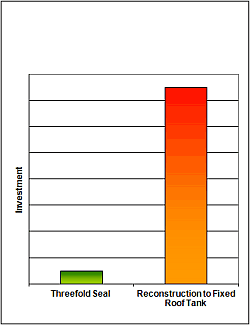Legal Requirements for Tanks with Floating Roof Technology
The legislators in Europe have issued minimum requirements for emission control of hydrocarbon storage tanks. When storing Otto-Gasoline the rules of directive 94/63 CE shall apply in Europe. In Germany the additional rules of TA-Luft shall be met.
Directive 94/63 CE (Europe)
TA-Luft (2002) (Germany only)
Applicable for the storage of ...
Otto-Gasoline
Organic Liquids
New Storage Plants
- Floating roof tanks and fixed roof tanks with internal floating cover must be equipped with sealing systems which give a minimum reduction of emission by 95%, in comparison to a fixed roof tank with the same tank data and storage service, equipped with pressure/ vacuum valve only, but without floating cover..
- Floating roof tanks shall be equipped with a primary seal and a secondary seal (Double Seal).
- The storage of liquid hydrocarbons with vapour pressures above 1,3 kPa at 20°C is only accepted in fixed roof tanks with connection to a gas collecting system or a gas cleaning system.
- Crude oil can be stored in floating roof tanks or fixed roof tanks with an internal floating cover, if the tank capacity exceeds 20.000 m3 and the efficiency of these tanks is a minimum of 97% compared to a fixed roof tank with the same data and service but without a floating cover.
Existing Storage Plants
- Floating roof tanks shall be equipped with a primary and a secondary seal. The efficiency of the tank must exceed a minimum of 95% compared to a fixed roof tank with the same tank data and storage service, equipped with pressure/vacuum valve only, but without a floating cover.
- Fixed roof tanks with an internal floating cover shall have a sealing system guaranteeing a minimum efficiency of 90% compared to a fixed roof tank with the same data and service but without a floating cover.
- The storage of liquids with vapour pressure above 1,3 KPa at 20ºC, but without toxic substances, is accepted in floating roof tanks or fixes roof tanks with an internal floating cover, if the reduction of emission in these tanks exceeds 97%. This rule is also applicable for storage products with benzene content less than 1%, (regardless of the vapour pressure). This rule has to be applied by 30.10.2007.
- If the storage liquid contains toxic substances, e.g. more than 1% benzene, the tanks have to be connected to a gas collecting system or a gas cleaning system within 12 years (30.10.2014).
Floating Roof Tank with Threefold Floating Roof Seals instead of Fixed Roof Tank Reconstruction with Connection to Gas Balancing and Gas Cleaning.
Today, many experts and authorities in Germany discuss alternative solutions to the requirements of TA-Luft 2002, which demanded the reconstruction of floating roof tanks to fixed roof tanks with connection to gas cleaning systems.
Based on practical experiences, we are convinced that IMHOF offers an alternative with much better environmental and economic results by installing threefold sealing systems in floating roof tanks.
Emission reductions exceeding 99%, in comparison to fixed roof tanks without a floating cover, is possible by using threefold periphery seals along with advanced sealing systems for the guide poles and roof legs.
The reconstruction of a floating roof tank into a fixed roof tank with a connection to a gas cleaning system, not only results in very high costs but also much higher overall emissions from all systems and activities involved. Hence an increased efficiency of floating roofs or floating covers is a much better solution compared to reconstructing a floating roof system into a fixed roof system with gas cleaning.
The road to success is to avoid emission at the source of emission, instead of destroying or condensing vapours, which easily can be avoided.
Comparison of costs:
 Reconstruction of the floating roof tank into a fixed roof tank or equipping the floating roof tank with a threefold seal.
Reconstruction of the floating roof tank into a fixed roof tank or equipping the floating roof tank with a threefold seal.
The comparison shown only refers to the necessities of the tank. When reconstructing to a fixed roof tank system enormous additional costs have to be considered for vapour balancing lines, gas holders, vapour recovery units and utilities and services required. It is obvious, that for existing storage tanks, as well as for storage tanks to be built in refineries and large scale storage farms, the application of vapour balancing techniques is not the optimal solution.
From an environmental and economical point of view, a vapour balancing and vapour recovery system is only useful for the system petrol depot, transport, and petrol station.
Threefold Floating Roof Seals instead of Aluminium Domes
Retrofitting external floating roof tanks with aluminium dome roofs can be seen critical today (see article „Aluminium domes under scrutiny“Tank Storage Magazine, June 2011).
The problem of rainwater free storage of refined products is solved since many years by the application of water –absorbent secondary seals (see article „Aluminium domes under scrutiny“ Tank Storage Magazin, June 2011).
The impact of wind to emissions can be minimized by application of an additional secondary or tertiary seal.
Also after the installation of aluminium dome roofs you will find remarkable quantities of emission. After long term emission tests with free vented fixed roof tanks with internal floating covers in Switzerland the conclusion was that emissions are mainly created by high tank wall temperatures due to sun radiation.
Any additional tank roof, in steel or aluminium has relatively little effect to emission. The governing means for emission reduction are:
- a solid floating roof
- high quality sealing systems
- cooling of tank walls, by highly reflecting tank paint, tank wall insulation or tank wall shadowing.
This means successful emission reduction is materialized
- at the surface of the liquid, and
- at the tank walls.
All additional means and methods result in high investment, additional risks and substitutional emissions outside the tank farm.





